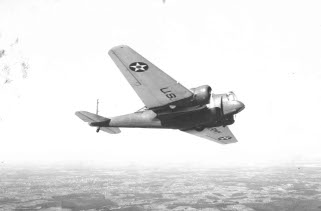![]() The Pacific War Online Encyclopedia
The Pacific War Online Encyclopedia
|
| Previous: Aziz Ahmed | Table of Contents | Next: B-17 Flying Fortress |

Martin B-10
| Crew | 4 or 5 |
| Dimensions | 70’6” x 45’ x
15’5” 21.49m by 13.72m by 4.70m |
| Wing area | 678 square feet 63.0 square meters |
| Weight | 8870-14,600 lbs 4023-6622 kg |
| Speed | 213 mph (343 km/h) at 10,000 feet (3000m) 196 mph (315 km/h) at sea level |
| Cruising speed | 193 mph 311 km/h |
| Landing speed | 65 mph 105 km/h |
| Climb rate | 24 feet per second 7.4 m/s |
| Service ceiling | 25,200 feet 7680 m |
| Power plant | 2 775 hp (578 kW) Wright R-1820-33 9-cylinder radial engines driving three-blade variable pitch propellers. |
| Armament | 1 0.30 machine gun
in nose turret 1 0.30 machine gun in rear cockpit 1 0.30 machine gun in rear ventral hatch |
| Bomb load | 2000 lbs 907 kg |
| Range | 1240 miles (2000 km) with 2000 lbs (907 kg) bombs 1830 miles (2900 km) ferry. |
| Fuel | 226-452 gallons (856-1710 liters) 720 gallons (2700 liters) ferry |
| Production | 479 by 1936 at Glenn L. Martin Company, Cleveland, OH. |
| Variants |
The B-10, B-12, and B-14 were minor
variations on the
basic Model
139. The Model 166 had an improved “greenhouse” canopy. |
The Martin Bomber was an innovative
bomber design when it
first entered production in 1936, with such advanced features as
cantilevered
wings, flaps, all-metal monocoque construction, retractable landing
gear, and
variable pitch propellers. However, it was hopelessly obsolete by the
start of
the Pacific War, and most of those still with U.S.
forces were converted to target tugs.
The Dutch
had deployed about 138
in the Netherlands
East Indies
when war broke out, and they were more successful in combat than they
had any
right to be.
References
The Pacific War Online Encyclopedia © 2007, 2009 by Kent G. Budge. Index